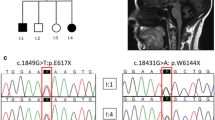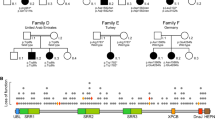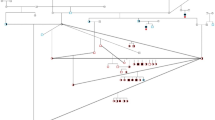Abstract
Autosomal recessive spastic ataxia of Charlevoix-Saguenay (ARSACS) was originally found among inhabitants of the Charlevoix-Saguenay region of northeastern Quebec in Canada. This disease is a neurodegenerative disorder characterized by early-onset spastic ataxia, dysarthria, nystagmus, distal muscle wasting, finger and foot deformities, and retinal hypermyelination. The principal neuropathology comprises atrophy of the upper vermis and the loss of Purkinje cells in the cerebellum. The SACS gene was originally reported to consist of a single gigantic exon spanning 12.8 kb with an 11.5-kb open reading frame (ORF), and to encode the protein sacsin. Recently, eight exons upstream from the original gigantic one, however, have been found, and the new ORF has elongated to 13.7 kb. To date, at least 28 mutations have been found in Quebec and non-Quebec patients including ones in Italy, Japan, Spain, Tunisia, and Turkey, and ARSACS thus shows a worldwide occurrence. Although most of the mutations reported have been in the gigantic exon, the genotype is now expanding upstream from this gigantic exon. Therefore, the new exons upstream of the gigantic one should be analyzed when a case is clinically compatible with ARSACS, even without any mutation in the gigantic exon. Although Quebec patients show a homogeneous phenotype, non-Quebec patients exhibit some atypical clinical features, as follows: slightly later onset than that in Quebec patients, absence of retinal hypermyelination, intellectual impairment, and lack of spasticity. Thus, since ARSACS shows the clinical diversity, the SACS gene should be analyzed not only in typical cases as Quebec patients but also in atypical cases as non-Quebec patients. As more SACS mutations are identified worldwide, the clinical spectrum of ‘sacsinopathies’ will expand, and a finer genotype-phenotype correlation study will become possible and shed light on the molecular mechanism underlying ARSACS.
Similar content being viewed by others
References
Bouchard JP, Barbeau A, Bouchard R, Bouchard RW. Autosomal recessive spastic ataxia of Charlevoix-Saguenay. Can J Neurol Sci. 1978;5:61–9.
Bouchard JP. Recessive spastic ataxia of Charlevoix-Saguenay. In: de Jong JMBV, editor. Handbook of clinical neurology 16: Hereditary neuropathies and spinocerebellar degenerations. Amsterdam: Elsevier Science, 1991. pp 451–9.
Bouchard JP, Richter A, Mathieu J, Brunet D, Hudson TJ, Morgan K, et al. Autosomal recessive spastic ataxia of Charlevoix-Saguenay. Neuromusc Dis. 1998;8:474–9.
De Braekeleer M, Giasson F, Mathieu J, Roy M, Bouchard JP, Morgan K. Genetic epidemiology of autosomal recessive spastic ataxia of Charlevoix-Saguenay in northeastern Quebec. Genet Epidemiol. 1993;10:17–25.
Heyer E. Genetic consequences of differential demographic behavior in the Saguenay region, Quebec. Am J Phys Anthropol. 1995;98:1–11.
Duquette A, Roddier K, McNabb-Baltar J, Gosselin I, St-Denis A, Dicaire M-J, et al. Mutations in senataxin responsible for Quebec cluster of ataxia with neuropathy. Ann Neurol. 2005;57:408–14.
Laberge A-M, Michaud J, Richter A, Lemyre E, Lambert M, Brais B, et al. Population history and its impact on medical genetics in Quebec. Clin Genet. 2005;68:287–301.
Richter A, Rioux JD, Bouchard J-P, Mercier J, Mathieu J, Ge B, Poirier J, et al. Location score and haplotype analyses of the locus for autosomal recessive spastic ataxia of Charlevoix-Saguenay, in chromosome region 13q11. Am J Hum Genet. 1999;64:768–75.
Bouchard JP, Richter A, Melancon SB, Mathieu J, Michaud J. Autosomal recessive spastic ataxia (Charelevoix-Saguenay). In: Klockgether T, editor. Handbook of ataxia disorders. New York: Marcel Dekker, 2000. pp 311–24.
Engert JC, Bérubé P, Mercier J, Doré C, Lepage P, Ge B, et al. ARSACS, a spastic ataxia common in northeastern Québec, is caused by mutations in a new gene encoding an 11.5-kb ORF. Nat Genet. 2000;24:120–5.
Criscuolo C, Banfi S, Orio M, Gasparini P, Monticelli A, Scarano V, et al. A novel mutation in SACS gene in a family from southern Italy. Neurology. 2004;62:100–2.
Grieco GS, Malandrini A, Comanducci G, Leuzzi V, Valoppi M, Tessa A, et al. Novel SACS mutations in autosomal recessive spastic ataxia of Charlevoix-Saguenay type. Neurology. 2004;62:103–6.
Criscuolo C, Sacca F, De Michele G, Mancini P, Combarros O, Infante J, et al. Novel mutation of SACS gene in a Spanish family with autosomal recessive spastic ataxia. Mov Disord. 2005;20:1358–61.
El Euch-Fayache G, Lalani I, Amouri R, Turki I, Ouahchi K, Hung WY, et al. Phenotypic features and genetic findings in sacsin-related autosomal recessive ataxia in Tunisia. Arch Neurol. 2003;60:982–8.
Richter AM, Ozgul RK, Poisson VC, Topaloglu H. Private SACS mutations in autosomal recessive spastic ataxia of Charlevoix-Saguenay (ARSACS) families from Turkey. Neurogenetics. 2004;5:165–70.
Ogawa T, Takiyama Y, Sakoe K, Mori K, Namekawa M, Shimazaki H, et al. Identification of a SACS gene missense mutation in ARSACS. Neurology. 2004;62:107–9.
Shimazaki H, Takiyama Y, Sakoe K, Ando Y, Nakano I. A phenotype without spasticity in sacsin-related ataxia. Neurology. 2005;64:2129–31.
Yamamoto Y, Hiraoka K, Araki M, Nagano S, Shimazaki H, Takiyama Y, et al. Novel compound heterozygous mutations in sacsin-related ataxia. J Neurol Sci. 2005;239:101–4.
Yamamoto Y, Nakamori M, Konaka K, Nagano S, Shimazaki H, Takiyama Y, et al. Sacsin-related ataxia caused by the novel nonsense mutation Arg4325X. J Neurol. 2006;253:1372–3.
Ouyang Y, Takiyama Y, Sakoe K, Shimazaki H, Ogawa T, Nagano S, et al. Sacsin-related ataxia (ARSACS): expanding the genotype upstream from the gigantic exon. Neurology. 2006;66:1103–04.
Takiyama Y. Autosomal recessive spastic ataxia of Charlevoix-Saguenay (ARSACS). Neuropathology. 2006;26: 368–75.
Hara K, Onodera O, Endo M, Kondo H, Shiota H, Miki K, et al. Sacsin-related autosomal recessive ataxia without prominent retinal myelinated fibers in Japan. Mov Disord. 2005;20:380–02.
Okawa S, Sugawara M, Watanabe S, Imota T, Toyoshima I. A novel sacsin mutation in a Japanese woman showing clinical uniformity of autosomal recessive spastic ataxia of Charlevoix-Saguenay. J Neurol Neurosurg Psychiatry. 2006; 77:804.
Gomez CM. ARSACS goes global. Neurology. 2004;62: 10–11.
Chio A, Orsi L, Mortara P, Schiffer D. Early onset cerebellar ataxia with retained tendon reflexes: prevalence and gene frequency in an Italian population. Clin Genet. 1993;43: 207–11.
De Castro M, Cruz-Martinez A, Vilchez JJ, Sevilla T, Pineda M, Berciano J, et al. Early onset cerebellar ataxia and preservation of tendon reflexes: clinical phenotypes associated with GAA trinucleotide repeat expanded and non-expanded genotypes. J Peripher Nerv Syst. 1999;4: 58–62.
Wilkinson PA, Crosby AH, Turner C, Bradley LJ, Ginsberg L, Wood NW, et al. A clinical, genetic and biochemical study of SPG7 mutations in hereditary spastic paraplegia. Brain. 2004;127:973–80.
Simpson MA, Cross H, Proukakis C, Pryde A, Hershberger R, Chatonnet A, et al. Maspardin is mutated in mast syndrome, a complicated form of hereditary spastic paraplegia associated with dementia. Am J Hum Genet. 2003;73:1147–56.
Meijer IA, Cossette P, Roussel J, Benard M, Toupin S, Rouleau GA. A novel locus for pure recessive hereditary spastic paraplegia maps to 10q22.1–10q24.1. Ann Neurol. 2004;56:579–82.
Krebe S, Azzedine H, Durr A, Bastien P, Bouslam N, Elleuch N, et al. Autosomal recessive spastic paraplegia (SPG30) with mild ataxia and sensory neuropathy maps to chromosome 2q37.3. Brain. 2006;129:1456–62.
Klockgether T, Petersen D, Grodd W, Dichgans J. Early onset cerebellar ataxia with retained tendon reflexes: clinical, electrophysiological and MRI observations in comparison with Friedreich’s ataxia. Brain. 1991;114:1559–73.
De Michele G, Mainenti PP, Soricelli A, Di Salle F, Salvatore E, Longobardi MR, et al. Cerebral blood flow in spinocerebellar degenerations: a single photon emission tomography study in 28 patients. J Neurol. 1998;245:603–8.
Peyronnard JM, Charron L, Barbeau A. The neuropathy of Charlevoix-Saguenay ataxia: an electrophysiological and pathological study. Can J Neurol Sci. 1979;6:199–203.
Filla A, Criscuolo C, Mancini P, Di Giandomenico S, Cicala D, De Michele G, et al. Screening for SACS mutations in autosomal recessive spastic ataxias. Neurology. 2006;66:A288, P05.113 (Abstr.).
Mercier J, Prévost C, Engert JC, Bouchard JP, Mathieu J, Richter A. Rapid detection of the sacsin mutations causing autosomal recessive spastic ataxia of Chairlevoix-Saguenay. Genet Test. 2001;5:255–9.
Shimazaki H, Sakoe K, Nijima K, Nakano I, Takiyama Y. An unusual case of a spasticity-lacking phenotype with a novel SACS mutation. J. Neurol Sci (in press).
Author information
Authors and Affiliations
Corresponding author
Rights and permissions
About this article
Cite this article
Takiyama, Y. Sacsinopathies: Sacsin-related ataxia. Cerebellum 6, 353–359 (2007). https://doi.org/10.1080/14734220701230466
Published:
Issue Date:
DOI: https://doi.org/10.1080/14734220701230466




